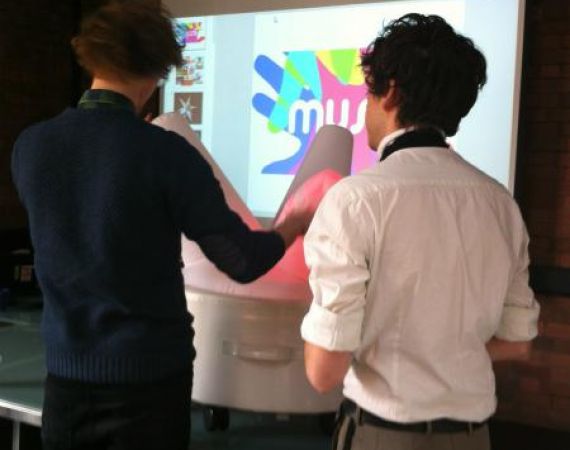Posted on Mon 8 Apr 2013
Introducing Musii: Lunchtime Talk Write-Up
Imagine an inflatable structure, with 3 inflated arms wafting gently as the air blowing through keeps them reaching upwards. The material is warm to the touch, like a parachute or a hot air balloon. When you reach out to touch it, push it, squash it, something surprising happens. Imagine that as you…

Getting hands on with Musii
Posted by
Imagine an inflatable structure, with 3 inflated arms wafting gently as the air blowing through keeps them reaching upwards. The material is warm to the touch, like a parachute or a hot air balloon. When you reach out to touch it, push it, squash it, something surprising happens. Imagine that as you compress the first prong, it glows a cool blue and plays you a minor scale as if on a bass guitar, the note getting higher as you compress it further. You clasp another arm and it glows red, adding a drum beat to your sound, you let them both go and tentatively nudge at the remaining frong. Now your inflatable structure is green and making a sound like the one that film makers give to the sun bursting through the clouds.
This is how we started a lunchtime talk with the creators of Musii (Multi-sensory Interactive Inflatable), renowned artists Luke (Filthy Luker) and Lex (Jnr Hacksaw) on 5 April.
Luke and Lex have a long history of creating extraordinary inflatable work for festivals and as street art, whether it be giant stars that pulse with glowing light in response to the music, or unfeasibly large tentacles that burst from the windows of buildings. From the moment Luke’s long-term collaborator Pete Hamilton realised that you could inflate a bag with a hairdryer in 1994, their obsession with inflatables was born. Inflatables are an incredibly versatile and underused medium for artists, transforming flat cloth into 3D shapes and allowing large-scale, complex work to be packed away, transported and installed almost anywhere very easily.
There is no rule book for inflatable art so Luke experimented with ever larger and weirder shapes and combinations, drawing inspiration from the likes of William Latham to make shapes that could only be produced through computational mathematics or seen under a microscope. He found that abstract shapes and forms allowed and encouraged people to use their imagination and invent ways to interact, something that figures and cartoon characters simply did not.
In a parallel universe, Lex had been experimenting for 20 years in electronic music, never happy standing behind a keyboard, or latterly a laptop, Lex has deployed all manner of creative technological solutions to keeping his DJ sets performative and his music responsive and instinctive. He used a Theremin to control pitch and volume and thingamebob’s (yes, really) to trigger sounds with light, but found both to be somewhat erratic and effects were difficult to repeat with no tactile feedback or in the absence of a controlled environment.
Lex and Luke have collaborated again and again over the years to incorporate animatronics, sound, light and interactivity to their work. Interestingly, the first experiments that led to Musii were born of a joint attempt to create new modes of play for their inflabables in clubs and festivals, using proximity sensors to trigger new sounds, colours or causing new parts to infate as people approached, and in doing so avoiding the normal 'jump on it til it is destroyed' situation.
They were struck by the absence of software/hardware available to sequence and control lighting in the way that MIDI allows you to control music. Lex wanted to create a controller that used all 3 colours of the light spectrum (RGB) and that had the 4 axis motion control of a joystick, rather than the straight – on/off – of similar controllers.
Musii is the cumulative response to all of these technological and design challenges. It has been a couple of years in the making, refining the components to make them robust, appropriate and affordable and now has it’s full CE mark and is ready to go. Although it is a mesmerising and fun experience for anyone, Luke and Lex particularly have their eyes on the children’s and special educational needs markets, having had fantastic responses from placing them in sensory room and SEN environments. Musii encourages play, music making and movement without the player needing to have any pre-existing skills or programming expertise, and enabling those with limited mobility or social confidence to get creative.
Questions:
Could you rent it out to kids parties?
We can or would do kids parties but see this as a possible sideline to selling them to SEN and mainstream schools for now.
How much does it cost?
Approximately £2000, which is considerably lower than their next nearest competitor, a product that does not involve any tactile feedback.
Could you use it as a remote to control, say, the lights in your house or change tracks on your iPod?
Yes! Cool ideas. The Musii comes with a number of sets of sounds but you can plug it easily into a computer if you are a little more technically inclined and map your own sounds or to configure it to trigger other actions.
Would you consider bringing musii to your existing festival clients?
It’s a possibility and we probably will to a certain extent – Lex is working on some sound maps that are much more dance-y than the current, more ambient sounds, but they want to focus on therapeutic benefits for now.
Could it be made in different shapes, have more spikes perhaps?
Once we have musii mo (the current mobile unit) selling we can start to make new shapes and versions - big ones with big speakers inside for large gatherings, inflatable rooms where the walls are reactive, colour changing. Also the way you can play music has scope for development. We can see it becoming more like an instrument, using sensors triggering filters to effect the sound youre making.
To find out more visit musii.co.uk
